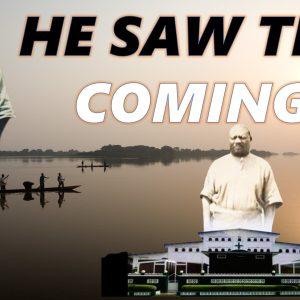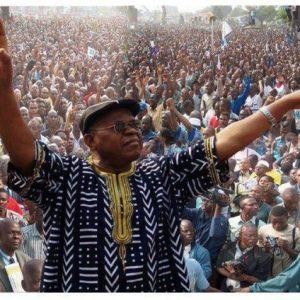Congolese pre-colonial Kingdoms
The Democratic Republic of Congo is a vast territory that has seen many interesting events, including those of pre-colonial kingdoms. In this part of Congotalks243, we will debrief the history of the kingdom of Kongo or Kongo Dia Ntotila, one of the largest kingdoms in Central Africa.
THE KINGDOM’S ORIGIN
The Kingdom of Kongo was founded by King Lukeni Lua Nimi or Ntinu Wene in 1375 following an alliance between two different kings: Nimi a Nzima king of Pemba who married Lukeni Lua Nzanze daughter of Nsaku Lau king of Mbata. Lukeni Lua Nimi after conquering the state of Mwene Kabunga created the Kingdom of Kongo by putting the capital at Mbanza Kongo.

They decided to make the descendants of Nimi a Nzima from Pempa sovereigns those of Nsaku should govern in Mbata by ensuring the application of this law of succession, thus Lukeni Lua Nimi son of Nimi a Nzima and Lukeni Lua Nzanze, was the first King and founder of the Kingdom of Kongo whose capital was Mbanza Kongo(San Salvador) in Angola.
KINGDOM OF KONGO LOCATION
The Kingdom of Kongo was located in northern Angola, southern Gabon, the Republic of Congo, and the western Democratic Republic of Congo. At its peak, the empire extended to the Kwango River, the Congo River, and the Atlantic Ocean. The Kingdom of Kongo covered a total area of about 2,500,000 km².

ECONOMY
The Kongo Dia Ntotila or the kingdom of Kongo lived from agriculture: the cultivation of manioc, sweet potatoes, cereals, and peanuts. The people also lived from fishing, cattle breeding, the Kingdom was already trading in ivory, raffia clothing, copper, and gold; the Kingdom had its currency called Mbongo
RELIGION
The Kongo people believed in their supreme god named Nzambi or Nzambe before being converted to Christianity. The people consulted a diviner or priest called Nganga, who served as an intermediary between them and their God Nzambi. This belief of having an intermediary between humans and their God is common to many Bantu people. The Baluba, for instance, had a Kitobo (as a Nganga for Bakongo) who was connecting them to their God Nvidye Mukulu.
THE INTRODUCTION OF CHRISTIANITY
During an expedition led by the Portuguese Diego Cao in 1483, he decided to stop in the kingdom, he left for Portugal taking some Kongo nobles with him, then he returned after 2 years. The reigning king wanted to convert to Christianity and sent a delegation of nobles with Diego Cão to Europe to learn Christianity, to learn how to read and to write. 5 years later Cão returned with roman catholic priests and soldiers in 1491. It was then that King Nzinga a Nguwu was baptized as Joao I.

His son, successor to the throne, Mvemba a Nzinga or Alfonso I, was the one who extended Christianity to the entire kingdom. According to some authors (Graziano Saccardo: Congo e Angola con la storia dell’antica missione dei cappuccini. Vol. 3 published by Venise Mestre), the Kingdom of Kongo was converted to Christianity for political and economic rather than religious reasons.
CULTURE
The culture of the Kingdom of Kongo was characterized by its pottery, art, and its language. The shaping of pottery with a cone of clay and a rounded base identified in all the centers of production of traditional Kongo ceramics, The assembly of pottery with doves, The decoration of pottery with bridelia ferruginea by all the Kongo potters. Art: Specter sculptures or Nkisi represent sacred objects belonging to Kongo chiefs. These sacred objects or Nkisi were embodied by a divine spirit. Its language: The Kongo people spoke Kikongo which is one of the Congolese national languages (I invite you to learn Kikongo on our YouTube channel where the Congolese culture is highlighted) but it is also spoken in the republic of Congo, in Angola and a bit in a part of Gabon.
THE POLITICAL SYSTEM OF KINGDOM OF KONGO
By its creation the kingdom of Kongo had a matrilineal succession and a political system of constitutional or absolute monarchy, but the political system or the way in which power passed from one king to another was not maintained the same throughout the existence of the kingdom. The kingdom was ruled by a Sovereign King bearing the title of Mwene Kongo or Mani Kongo which means King of Kongo or Chief of Kongo, it was a highly centralized political system.
The King presided from the capital Mbanza Kongo. The sovereign Kongo king or Mwene Kongo was elected by a council of elders and a set of governors (even Portuguese officers) and then the guardians of the spiritual and political principles from the Nsaku lineage would perform a ritual ceremony
THE KINGDOM’S APOGEE
The kingdom had its moment of glory under the reign of King Mvemba a Nzinga in 1509, thanks to the production and trade of weapons, and agricultural products which contributed to the rise of the Kingdom of Kongo.
KINGDOM’S DECLINE
The Kingdom of Kongo was a kingdom that covered the Democratic Republic of Congo, the Republic of Congo, Angola, and a small part of Gabon. It was created by Lukeni Lua Nimi or Ntinu Wene in 1375, it reached its apogee under the reign of King Mvemba a Nzinga between the 16th and 17th century, and it started to fall at the end of the same century to completely disappear in the 20th century with colonization.
You can find captivating topics about congolese pre-colonial Kingdoms on the Congotalks243 website or watch the videos on YouTube. I invite you to follow us on our Facebook, Instagram and Twitter pages.
CONCLUSION
The Kuba kingdom was created following the migrations of the Mongo-speaking people in the 1600s. It was founded by King Shyaam a’Mbul a Ngoong, and it was known for its art of raffia weaving, the making of monumental helmet masks and statues representing Kuba kings. Today, the kingdom still exists and is headed by a King known as Kot-a-Mbweeky III. The Kingdom is located in the Democratic Republic of Congo.
Want to know more about the DR Congo in general? We recommend you follow us on your favourite social media platforms: Instagram (@congotalks243 and @yafelie), Twitter (@congotalks243), TikTok (@yafelie and @congotalks243), Facebook (@CongoTalks243) and LinkedIn (@CongoTalks243), and subscribe to our YouTube channel.
✅ How to support our works: PAYPAL: https://paypal.me/CongoTalks243
For business inquiries related to CongoTalks243, you can reach out at info@congotalks243.com.



